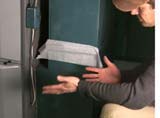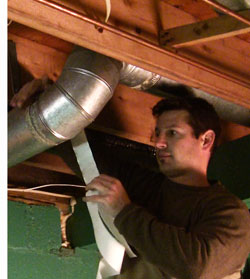Why You're Losing Money - Finding & Sealing Leaky Ducts
Finding the Leaks in your Ducts
A quick examination of your ducts may lead to some serious surprises. I was amazed to find holes so large that I could put my hand into the ducts. You may also find spots where ducts are completely disconnected. These are huge opportunities to improve the comfort of your home and save a lot of money.
Finding the big leaks is easy. You can actually feel the air blowing out.The smaller leaks are not as easy to find. Most leaks are in the joints where two ducts are connected together with screws.
 You can use an incense stick or a piece of ribbon or toilet paper to check for leaks. You can tell where your ducts are leaking by letting the smoke from the incense float up along the joints in the ductwork. If it swirls around irradically, you've got a leaky duct.Toilet paper and ribbons also move around when air is leaking from the duct.
You can use an incense stick or a piece of ribbon or toilet paper to check for leaks. You can tell where your ducts are leaking by letting the smoke from the incense float up along the joints in the ductwork. If it swirls around irradically, you've got a leaky duct.Toilet paper and ribbons also move around when air is leaking from the duct.
Suck and Blow
One thing you need to know about your ductwork that will help you find leaks. Your furnace or air conditioner have two types of ducts. One side blows air out and the other side sucks air in. So if you look up at the ductwork near the furnace, you should see two large metal boxes connected to it. The box that is connected to the top of the furnace usually blows air out. The one connected to where your filter is located sucks air in.
The only reason you need to know this is because during your examination, you may see holes or gaps in your ductwork that don't seem to be blowing air out. That's because they are sucking air in. Put a piece of toilet paper over the duct. If it hangs in place, you've got a leaky return duct.
 Sealing your Ducts
Sealing your Ducts
This is another easy DIY project that will save you money in a hurry. All you need is some special foil tape, silicone caulk, a bucket of mastic, fiberglass mesh tape and a cheap brush. Start by cleaning the ducts with a damp rag wiping off all of the dust and dirt. Then, wrap the foil tape around the joints where two sections of the metal ducts are connected. Press the foil tape firmly against the joints to make sure it stays there for a long time.
Although it's a little messier than foil tape, mastic is definitely your best bet for a permanent, air-tight seal. It's also really handy for odd shaped joints that are difficult to tape.
You can apply the mastic to the joint in one of two ways. One way is to stick your hand in the bucket and smear it around the joint. I'd recommend wearing cotton gloves to keep the sheet metal screws from cutting your hands. The other way is to dip a cheap, disposable paint brush into the bucket and paint it around the joint. Make sure you put plenty of mastic on the joint, "nickel thick" is the industry standard.
Sealing your Registers
The ducts in your basement or attic are connected to the rooms in your home. The air blows through the ducts until it reaches the registers. Make sure the money you've spent to heat or cool the air actually blows into the room by air sealing around the register. Air sealing around the register forces the air into the room instead of leaking into the wall, floor or ceiling.
Air sealing your registers is another easy DIY project. All you need to do is remove the register from the floor, wall or ceiling by loosening the screws. Set the register aside and put the screws in a ziplock bag and save them for later. With the register plate removed, look for gaps between the drywall or flooring and the metal duct box. Seal around the rim of the duct box with silicone caulk or mastic. Smear the caulk around the rim with your finger to create a strong bond. Then replace the register and move on the to the next room.











